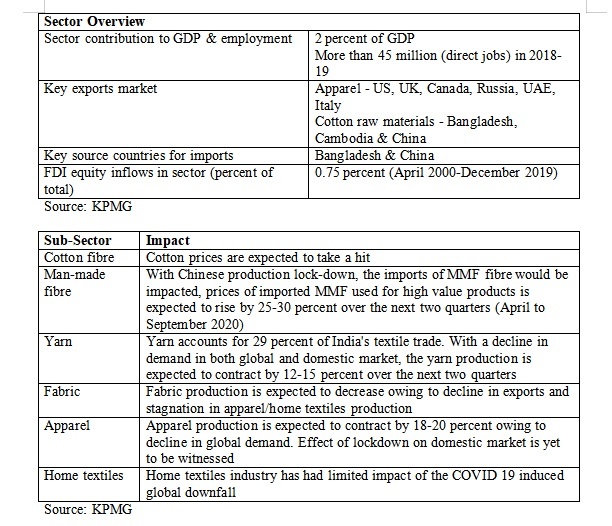
Due to the nation-wide lockdown to prevent the spread of novel coronavirus, the Indian apparel and textile sector is going through some extremely trying times. The central government had announced a 21-day lock-down starting March 24 to contain the pandemic. On Tuesday, this lockdown was further stretched up to May 3. The sector – which comes in the non-essential category – is likely to be impacted most due to declining demand and restricted supply-chain.

The Indian apparel and textile sector is the fourth largest producer of textile and garments in the world. The sector contributes 2 percent to the total GDP, employing more than 45 million workers and nurture manufacturing and retail businesses under it. The increase in the lockdown period has only added to the misery of the sector.
According to the Confederation of All India Traders (CAIT), the country’s retail sector, comprising 70 million small, medium and big traders employing 450 million people, undertakes a monthly business of about USD 70 billion (approximately Rs 5.2 lakh crore), and is one of the most impacted due to the global pandemic.
With around 80 percent of the garment industry mostly micro, small and medium enterprises, which has around 3,700 members employing over 7 lakh people, the Clothing Manufacturers Association of India (CMAI) asserts that most of its members do not have the kind of reserves to see them through 3-6 months.
While Retailers Association of India (RAI) confirms that about 40 percent of the 6 million employees working in India’s modern, rather than traditional, retail sector could likely lose their jobs in the next 4 months if the government does not intervene.
Furthermore, CAIT has warned that retail markets in urban centres will face an acute shortage of labour which have migrated to their towns and villages amid the coronavirus outbreak and the nationwide lockdown.
Though job-cuts is one of the major repercussions of the global pandemic which can have domino effect that ends with hampering consumerism. There are other more compelling parameters that are impacting the sector and its allied businesses.
Current & Potential Impact on the Sector
Supply-side
– Price variations of key raw materials: Though the prices of raw materials have remained stable, the demand has been hit
– Labour force: The sector is one of the largest employers in the country, employing over 45 million (direct jobs) and sizable number of contract labour as well. The nationwide lock-down has led to temporary closures of factories and lay-offs of low-wage workers
– Cash flow Constraints: The sector has been grappling with profitability issues due to a sharp decline in yarn exports, cheap imports, etc. Industry body Apparel Export Promotion Council (AEPC) says about 65 percent of apparel exporters payment amounting to at least USD2 billion (about Rs. 15,300 crore) is currently stuck with foreign buyers owing to either cancelling or postponing confirmed orders
– Supply-chain disruption: Garment manufacturers can look at local sourcing opportunities
– Imports: China is the fourth largest trading partner with India for purified terephithalic acid (PTA), and largest trading partner for polyester staple fibre (PSF). Thus, China’s slowdown has certainly added to current supplies to India
Demand-Side
– With the sector not making under the essential category under lock-down, the demand of goods has considerably declined
– Adhering to lockdown norms and following social distancing, consumer sentiments have been majorly affected. If the situation persists, the impact would be higher
– With a drastic fall in global demand and an export ban on certain critical raw materials (those used to make masks for example), the impact on exports is considerable
However, with the support of government and their prudent intervention these potential impacts can be checked. Moreover, if the contagion is controlled efficiently through effective timely interventions, the economy would resume back to life and witness normalcy soon.
Recommendations to Ease the Impact
– Considering the nationwide lock-down, tax compliances deadlines need to be extended and taxes need to be reviewed to minimize the impact of decline in demand
– The sector has been reeling under severe financial stress, so interest rate reduction should be considered under short-term recommendations to ease financial stress. And for long-term, credit ratings-based loan facilitation for MSME players should be reviewed in order to make the sector competitive/lucrative
– Tax reliefs need to be provided in an attempt to boost consumer spending and to support the end-customer
– A comprehensive financial support package along the lines announced in Germany and the US can be considered. Similarly, providing an adhoc reimbursement/concession of 5-10 percent against the recent approved Remission of Duties or Taxes on Export Product (RoDTEP) scheme to compensate for the hitherto unlimbered levies and taxes to the exporters.




